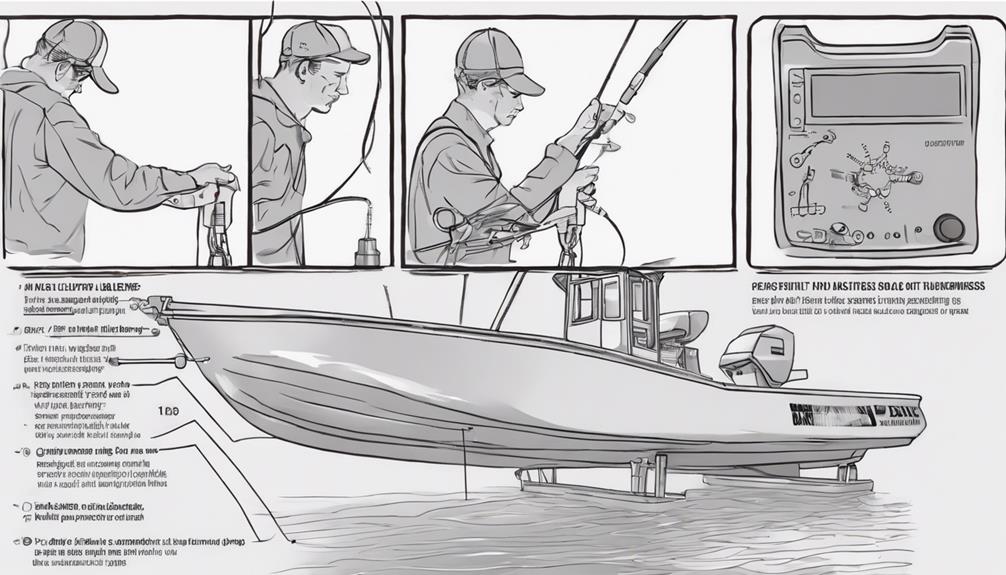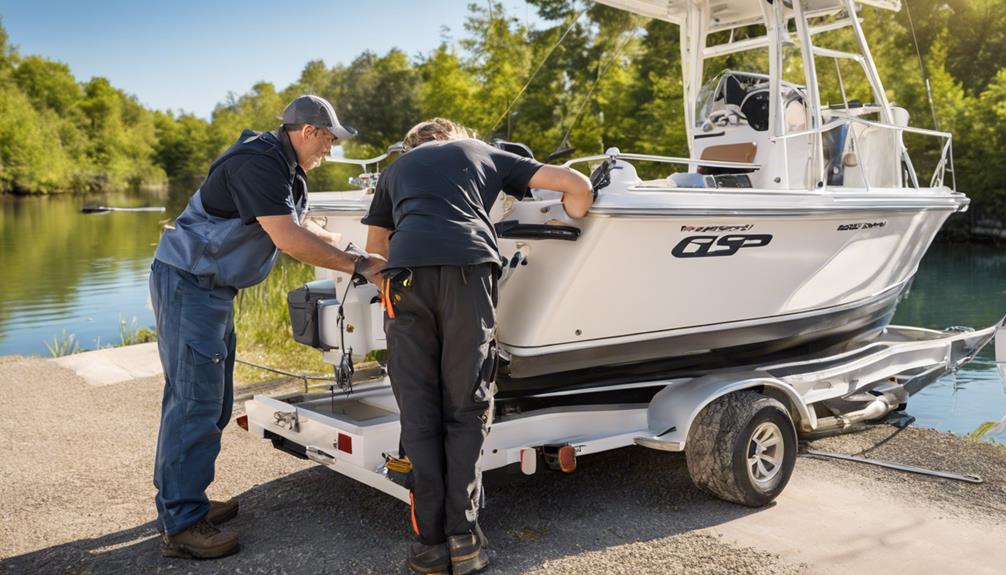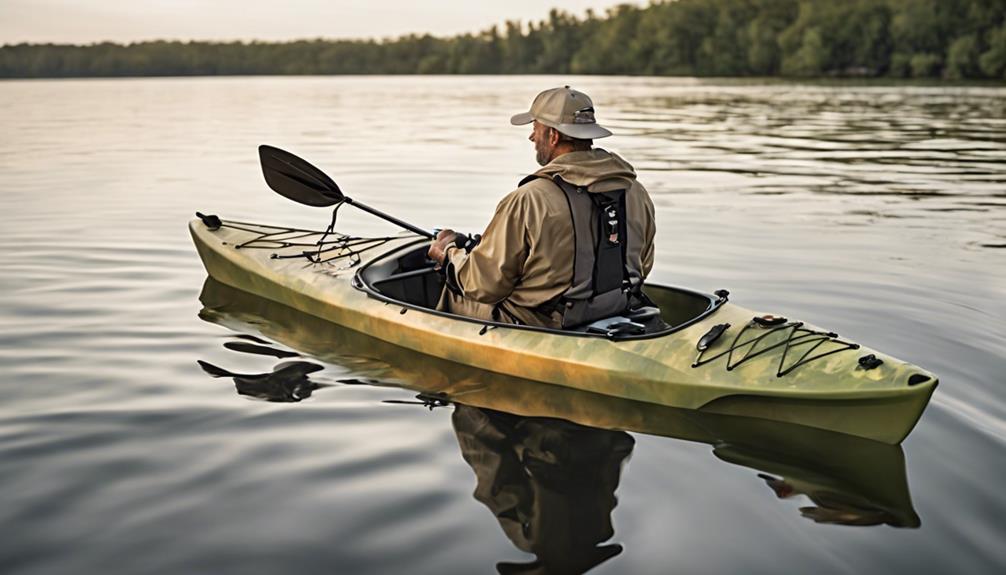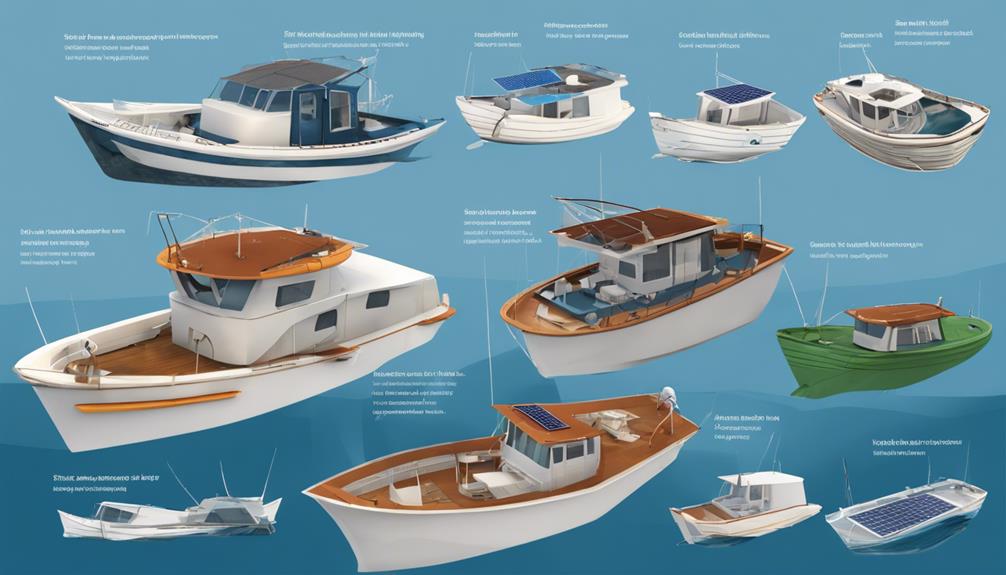When it comes to maintaining your aluminum fishing boat, think of it as tending to a well-oiled machine. Each component plays a crucial role in ensuring smooth sailing and enjoyable fishing trips.
From regular washing to inspecting the electrical system and keeping corrosion at bay, there are numerous tips that can help you keep your vessel in top shape.
So, grab your toolkit and get ready to give your aluminum fishing boat the care it deserves.
Washing and Cleaning
To maintain your aluminum fishing boat, regularly wash and clean it to prevent corrosion and maintain its appearance. Use gentle cleaning techniques like mild soap and water to avoid damaging the aluminum surface. Harsh chemicals can strip away protective coatings, leading to accelerated corrosion. When cleaning, pay special attention to areas prone to rusting, such as metal fittings and joints. A mixture of white vinegar and water can be effective in removing stubborn rust spots.
After cleaning, ensure proper drying to prevent water stains and streaks on the aluminum surface. Use a clean, soft cloth to dry the boat thoroughly, paying close attention to seams and crevices where water can collect. Proper drying not only helps in maintaining the boat's appearance but also prevents the formation of water-induced corrosion.
Regular maintenance of your aluminum boat is essential to prolong its lifespan. By following these cleaning and drying practices, you can keep your boat looking new while also protecting it from rust and corrosion. Remember, gentle cleaning, proper drying, and overall aluminum care are key to ensuring your fishing boat remains in top condition for years to come.
Corrosion Prevention
Proactively prevent corrosion on your aluminum fishing boat by implementing regular maintenance and protective measures. Rust prevention is crucial to keep your boat in top condition, especially when frequently exposed to saltwater. To combat corrosion, start by applying a high-quality marine wax to create a protective barrier on the aluminum surface. This will help shield your boat from the damaging effects of saltwater and other environmental factors. Additionally, consider investing in sacrificial anodes, also known as zincs, which can help prevent corrosion by attracting the oxidation process to themselves, sparing your boat from deterioration.
When it comes to saltwater protection, rinsing your boat with fresh water after every saltwater excursion is vital. Saltwater can accelerate the corrosion process, so a thorough rinse will help remove any salt residue that could lead to rust formation. Pay close attention to areas where saltwater tends to accumulate, such as hull crevices, fittings, and the engine. Regularly inspect these areas for any signs of corrosion and address them promptly to prevent further damage.
Electrical System Check
Combat potential electrical issues by conducting regular checks on your aluminum fishing boat's electrical system to ensure safety and smooth operation. Start by checking the battery to ensure it's in good condition. Perform battery testing periodically to verify its charge and health. A weak or faulty battery can lead to starting issues or cause electrical components to malfunction while out on the water.
Next, inspect the wiring throughout your boat. Look for any signs of wear, corrosion, or loose connections. Faulty wiring can lead to shorts, power failures, or even pose a fire hazard. Make sure all connections are secure and free of corrosion, as aluminum boats are particularly susceptible to corrosion that can affect the electrical system.
During your inspection, pay close attention to any exposed wiring that may have been damaged by water exposure or rodents. Replace any damaged wiring promptly to prevent electrical failures. Additionally, check for proper grounding to avoid electrical shock hazards.
Propeller Inspection
Regularly examine your aluminum fishing boat's propeller to ensure optimal performance and safety on the water. A well-maintained propeller is crucial for efficient propulsion and maneuverability. Here are some key points to consider during your propeller inspection:
- Check for Damage: Look for any signs of dings, dents, or bends on the propeller blades. Even minor damage can significantly affect performance.
- Inspect for Debris: Remove any debris such as fishing lines, weeds, or plastic bags that may be wrapped around the propeller shaft. These can cause imbalance and reduce efficiency.
- Monitor for Corrosion: Keep an eye out for any corrosion on the propeller blades or hub. Corrosion can weaken the propeller and lead to failure.
- Ensure Proper Alignment: Make sure the propeller is correctly aligned with the propeller shaft. Misalignment can cause vibrations and damage the propeller over time.
- Follow a Maintenance Schedule: Establish a regular maintenance schedule for propeller inspection, cleaning, and repair. Regular maintenance can help prevent costly repairs and extend the life of your propeller.
Trailer Maintenance
Effective trailer maintenance is essential for ensuring the safe transport and storage of your aluminum fishing boat. Start by regularly checking the tire pressure to prevent blowouts and ensure smooth towing. Proper tire inflation is crucial for maintaining stability and reducing the risk of accidents while on the road. Remember to inspect the tires for any signs of wear and tear, such as cracks or bulges, and replace them if necessary to guarantee a secure journey.
Another critical aspect of trailer maintenance is to regularly examine the brake lights. Functional brake lights are vital for signaling your intentions to other drivers and ensuring your safety on the road. Test the brake lights before each trip to confirm they're working correctly. Replace any bulbs that are burnt out and fix any wiring issues promptly to avoid accidents and potential fines.
Repainting and Sealing
To maintain the overall appearance and durability of your aluminum fishing boat, consider repainting and sealing it periodically to protect it from the elements. Proper paint selection and surface preparation are essential steps to ensure a long-lasting finish that withstands harsh marine conditions. Here are some handy tips for repainting and sealing your aluminum fishing boat:
- Paint Selection: When choosing paint for your aluminum boat, opt for marine-grade paints specifically designed for aluminum surfaces. These paints are formulated to adhere well to aluminum and provide excellent protection against water, UV rays, and corrosion.
- Surface Preparation: Before painting, thoroughly clean the boat's surface to remove any dirt, grease, or old paint. Use a suitable aluminum cleaner and a fine-grit sandpaper to create a smooth surface for the new paint to adhere to effectively.
- Primer Application: Apply a high-quality primer designed for aluminum surfaces to enhance paint adhesion and durability. The primer helps seal the aluminum and provides a strong base for the topcoat.
- Paint Application: Use a brush, roller, or sprayer to apply the paint evenly in thin coats. Allow each coat to dry completely before applying the next one to achieve a smooth and uniform finish.
- Sealing: Once the paint has dried, apply a clear marine-grade sealant to protect the paint and provide an extra layer of defense against water infiltration and UV damage. Regularly inspect the painted surfaces and reseal as needed to maintain the protective barrier.
Steering System Care

Maintain the steering system of your aluminum fishing boat by regularly inspecting for any signs of wear or corrosion. Proper maintenance of the steering system is crucial to ensure smooth and safe operation while out on the water. One important aspect of steering system care is steering system lubrication. Make sure to grease any moving parts according to the manufacturer's recommendations to prevent excessive wear and tear.
Additionally, it's essential to check the cable adjustment of your steering system. Over time, cables can stretch or become misaligned, affecting the responsiveness of your boat's steering. Follow the manufacturer's guidelines on how to adjust the cables properly to maintain precise control of your vessel.
Regularly inspecting and maintaining your steering system won't only prolong its lifespan but also enhance your overall boating experience. By staying proactive and addressing any issues promptly, you can prevent costly repairs down the line and ensure that your aluminum fishing boat remains in top condition for years to come.
Safety Equipment Review
Inspect your safety equipment regularly to ensure it's in proper working condition for peace of mind while you're out on the water. Here are some essential items to review:
- Life jacket inspection: Check all life jackets for any signs of wear and tear, ensuring that they're still buoyant and properly secure. Replace any damaged or outdated life jackets.
- Emergency kit review: Go through your emergency kit to make sure all supplies such as first aid items, flashlight, batteries, and non-perishable food are present and not expired. Restock any missing or outdated items.
- Flare gun inspection: Verify the flare gun is in good condition, free of corrosion, and that the flares are within their expiration date. Flares are a crucial distress signal in emergencies.
- Distress signal check: Test any other distress signals you have on board, such as a whistle or signal mirror, to ensure they're functioning correctly and easy to access in case of an emergency.
Regularly maintaining and reviewing your safety equipment can make a significant difference in emergency situations. By taking the time to inspect these items before each outing, you can ensure that you're well-prepared for any unexpected events while enjoying your time on the water.
Frequently Asked Questions
How Often Should I Replace the Bearings on My Aluminum Fishing Boat Trailer?
When it comes to trailer maintenance for your aluminum fishing boat, bearing replacement is crucial. To prevent corrosion and ensure smooth operation, it's recommended to replace the bearings every 12-18 months or every 12,000 miles.
Regularly inspecting for wear and tear can help you catch any issues early on. Proper maintenance not only protects against rust but also extends the life of your trailer and ensures safer travels to your fishing destinations.
Is It Necessary to Inspect the Hull for Cracks or Damage After Each Fishing Trip?
After each fishing trip, you should inspect your boat's hull for cracks or damage. This is crucial for detecting any issues early on and preventing further damage. Regular hull inspections are key to maintaining your boat's integrity.
Additionally, checking for corrosion can help you address any potential problems before they worsen. By incorporating these practices into your maintenance schedule, you can ensure your boat stays in top condition for your next fishing adventure.
What Are Some Common Signs of Wear and Tear on an Aluminum Boat's Steering System?
When it comes to your aluminum boat's steering system, keep an eye out for signs of wear and tear. Issues like loose steering, difficulty turning, or strange noises can indicate problems.
Regularly inspecting and lubricating steering components can help prevent corrosion and ensure smooth operation. Troubleshooting tips include checking for leaks, worn parts, or misalignments.
Proper steering system maintenance is essential for safe and enjoyable boating experiences.
Can I Use Any Type of Cleaning Solution to Remove Saltwater Residue From My Aluminum Boat?
You shouldn't use any cleaning solution for removing saltwater residue from your aluminum boat. To prevent rust and protect against corrosion, opt for proper cleaning methods and regular maintenance.
Using the right products and techniques will help preserve your boat's integrity and longevity. Consider investing in specialized cleaners designed for saltwater maintenance to keep your aluminum boat in top shape and ensure it lasts for many more fishing trips.
How Often Should I Replace the Wiring in My Aluminum Boat's Electrical System?
When it comes to your aluminum boat's electrical system, it's crucial to stay on top of wiring maintenance to prevent corrosion. Regularly inspect your wiring for any signs of wear or damage.
Considering the harsh marine environment, it's wise to replace the wiring every 5-7 years to ensure optimal performance and safety.
Conclusion
Now that you have learned these handy tips for maintaining your aluminum fishing boat, you can ensure it stays in top condition for all your fishing adventures.
By regularly washing and cleaning, preventing corrosion, checking the electrical system, inspecting the propeller, maintaining the trailer, repainting and sealing, caring for the steering system, and reviewing safety equipment, you can enjoy smooth sailing on the water for years to come.
Happy fishing!



